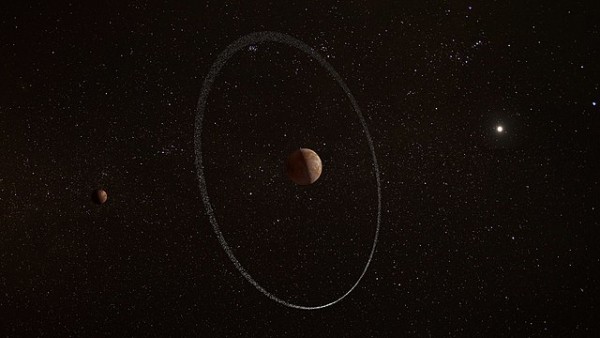Scientists are puzzled by the dense ring that surrounds a dwarf planet in the farthest limits of our solar system.
ESA Cheops Observed one of the 3,000 dwarf planets circling the Sun beyond Neptune called Quaoar, which is surrounded by a dense ring. According to CNN, it is 690 miles (1,110 kilometers) wide, making it the sixth largest planet after Pluto and Eris.
Quaoar is a group of tiny, far-off planets known as Trans-Neptunian objects (TNOs). 3000 or so TNOs have been found.
TNOs are found in the distant regions of the Solar System, beyond the orbit of Neptune, as their name implies.
Almost seven and a half times the radius of Quauar away, the CHaracterising Exoplanet Satellite (Cheops) mission of the European Space Agency discovered a thick ring. The scientists were unable to determine why it did not condense and create a little ring.
The ring was found in 2021 after a string of sightings between 2018 and 2021. Astronomers watched as Quaoar briefly blocked the light of a series of far-off stars using a number of ground-based telescopes and the space-based observatory Cheops.
Occultation is this kind of phenomenon. The size and shape of the occulting object may be determined by how the light of the occulted star diminishes, as well as whether or not the intermediary object has an atmosphere. The existence of material in orbit around Quaoar in this case was detected by smaller drops before and after the major occultation.
The findings from the Cheops mission, according to Kate Isaak, the ESA's project scientist for the mission, were essential in proving the existence of a ring around Quaoar. SciTechDaily claimed that the mission's more conventional exoplanet research is transcended by the use of high precision and high cadence photometry.
The Lucky Star project will continue to watch Quaoar and other TNOs as they obscure distant stars in order to quantify their physical characteristics and identify how many others have ring systems. This will be done while theorists investigate how the Quaoar rings may persist.
Cheops will return to its initial task of looking at neighboring exoplanets.
Due to their tiny sizes and great distances, studying these dwarf planets is difficult. Nearly 44 times as far as the Sun is from Earth, Quaoar circles the Sun.
Occultations are useful tools as a result. However, it was difficult to pinpoint exactly when and where they will happen until recently.
An occultation requires a very accurate alignment of the occulting object (in this example, the TNO), the star, and the viewing telescope.
The exact precision standards needed to be able to observe an event with certainty have historically been very difficult to satisfy.
The European Research Council Lucky Star project, directed by Bruno Sicardy of the Sorbonne University and Paris Observatory - PSL (LESIA), was established to achieve this goal. Its goal is to forecast impending TNO occultations and to organize global professional and amateur observatory observation of these events.
